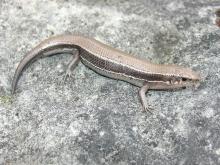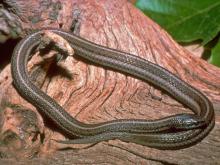Reptiles and Amphibians
Media

Species Types
Scientific Name
Storeria dekayi
Description
Dekay's brownsnake is a small, secretive species that prefers moist environments. It can be gray to brown to reddish brown. It usually has a tan stripe running down the back, bordered by two rows of small brown spots. The top of the head is usually dark. Occurs statewide.
Media

Species Types
Scientific Name
Scincella lateralis
Description
The little brown skink is a ground-dweller with dark brown or black stripes and speckling along the sides. Hiking in the woods, you may hear these small lizards scurrying through dead leaves, but you seldom see them. Occurs nearly statewide.
Media

Species Types
Scientific Name
Plestiodon anthracinus pluvialis
Description
The southern coal skink is secretive. It lives in the southern half of Missouri, excluding the Bootheel. Adults are small, shiny, and brownish, with a wide, coal-black line on the side. Juveniles are black with faint lines down the back and sides and a blue-gray tail.
Media

Species Types
Scientific Name
Tropidoclonion lineatum
Description
The lined snake looks similar to a gartersnake. It is brown to grayish brown, with three lighter-colored stripes down the length of its body and a double row of half-moon-shaped markings along the belly. It occurs mainly in the northwestern part of the state, along the northern border, with a separate population in the St. Louis area.
Media

Species Types
Scientific Name
Pseudacris fouquettei
Description
The Cajun chorus frog is a small tan to brown frog with dark dorsal stripes that are narrow or often broken into a series of dashes or spots. It occurs in a few counties in southeastern Missouri.
See Also
About Reptiles and Amphibians in Missouri
Missouri’s herptiles comprise 43 amphibians and 75 reptiles. Amphibians, including salamanders, toads, and frogs, are vertebrate animals that spend at least part of their life cycle in water. They usually have moist skin, lack scales or claws, and are ectothermal (cold-blooded), so they do not produce their own body heat the way birds and mammals do. Reptiles, including turtles, lizards, and snakes, are also vertebrates, and most are ectothermal, but unlike amphibians, reptiles have dry skin with scales, the ones with legs have claws, and they do not have to live part of their lives in water.





















